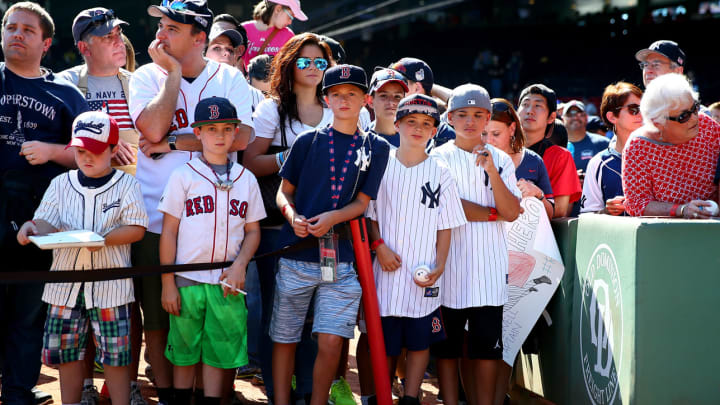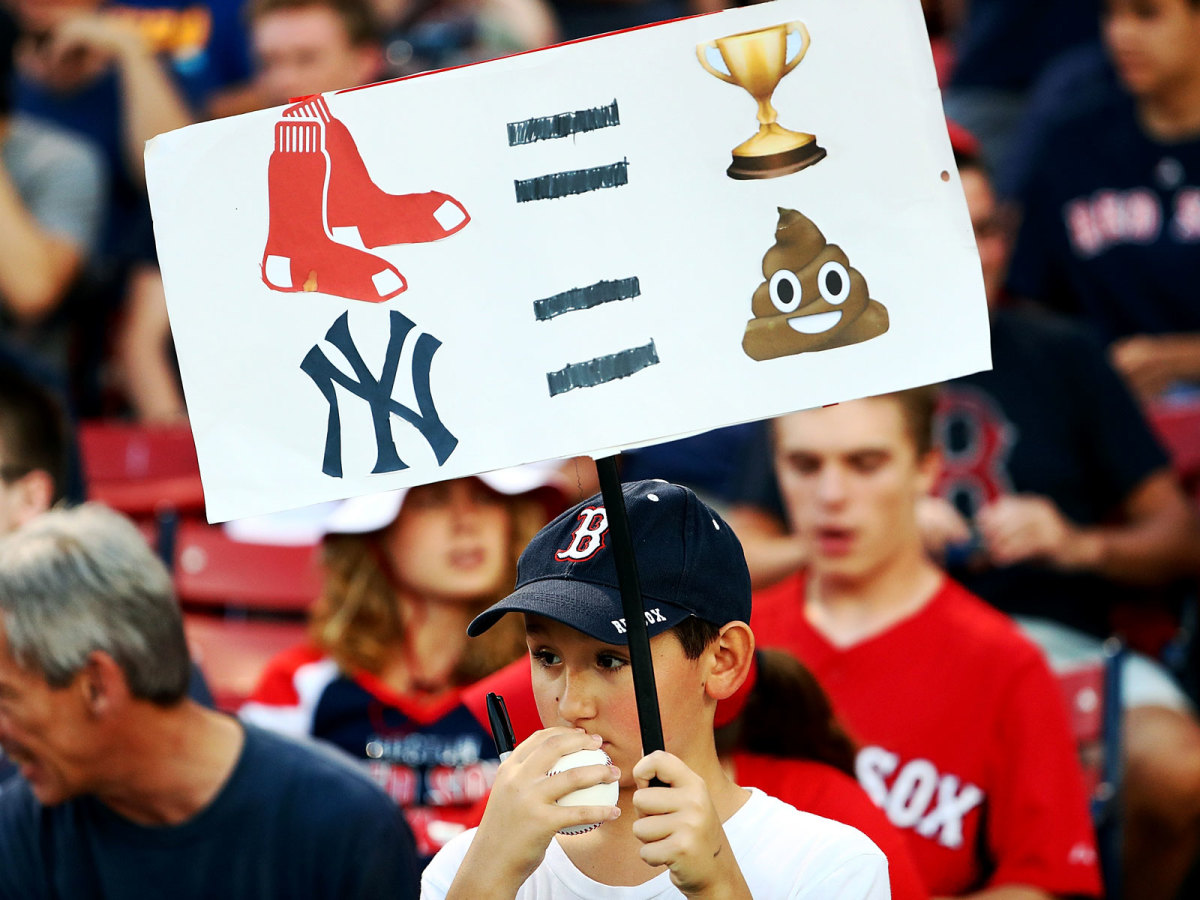What Makes Guilford, Connecticut the Perfect Wedge Between Yankees and Red Sox Fans

This week, SI will release 14 Back, Jon Hock’s stirring documentary about the Yankees’ furious comeback from that deficit to the Red Sox in the standings late in the summer of 1978. To sign up for SI TV, click here.
Numerous would-be cartographers over the years have tried to identify the exact location of what my colleague Steve Rushin in 2003 termed the Munson-Nixon line, named for former Yankees catcher Thurman Munson and Red Sox outfielder Trot Nixon. The line is the demarcation between Red Sox Nation and Yankees Universe (this is the official diplomatic nomenclature; no grandiosity here!), the border that signals red giving way to blue and poindexterism yielding to pugnacious front-running. But none can agree on where exactly to place it. Like the Housatonic River, the line flows north-south through Connecticut; unlike the Housatonic, large-scale industrial polluters have not dumped into it any known carcinogens. Good thing—the rivalry is toxic enough without them.
Roiling for more than a century, Red Sox–Yankees remains fiery and bitter, the envy of every pro league. The regular-season series exited its latest episode in August 2, 188 games old; the Yankees, as they had to, remained in the lead, 1,185–989 (with 14 ties thrown in for good measure, to show the rivalry’s age), even though the Red Sox, with a sweep, had inched four games closer to evening things up. Between the two clubs they have 35 championships (go ask Yankees fans how many are theirs; they’ll know), 30 AL MVPs and 12 Cy Young Awards (also, the actual Cy Young). Of the top 20 players all-time by Wins Above Replacement, nine played for Boston, New York or, in one case, both. That would be Babe Ruth, the player with the top WAR ever, who was sold from one franchise to the other—maybe you’ve heard?
Though much of the rivalry’s vinegar comes from the players, even more comes from the fans, many of whom approach Red Sox–Yankees games as if they are the only ones that matter. Lose to the Rays or the Orioles, well, that’s baseball. Lose to the Red Sox or the Yankees, heads must roll. Listening to New York’s WFAN after that recent August sweep, the callers sounded so despondent, I assumed at first that they were Mets fans. But for all their temperamentality, supporters of both teams also think generationally, even epochally, in a way the players and managers never have to. Consider the Bronx-dwelling but Boston-boosting cement mason who, in 2008, during the construction of the second Yankee Stadium, mixed a David Ortiz jersey into a batch of concrete used at the site and then blabbed about it. The Yankees swiftly jackhammered the jersey outta there, then referred the matter to the Bronx district attorney, who declined to press charges. Knowing that the job site would consist primarily of Yankees fans, team owner Hank Steinbrenner envisioned a different sort of justice: “I hope his coworkers kick the s--- out of him.”

Which brings me back to that border, and to the Connecticut communities far enough removed from New York and Boston to make partisans of both teams face one another, in equal numbers, after big games. I come to this topic as both an interested and disinterested party. One of the geographical studies, this one published in 2012 in The Wall Street Journal by Ben Blatt of the Harvard Sports Analysis Collective, drew on Facebook data to suggest that the locale most evenly divided between Yankees and Red Sox fans is Guilford, the shoreline town of 22,283 where I grew up. Before Blatt published his findings, Guilford’s greatest renown in baseball had come from Adam Greenberg, the Guilford High graduate who was beaned in his first big league plate appearance for the Cubs in 2005. After years in the independent leagues, he would get one more trip to the plate, for the Marlins in 2012. (He struck out.) Incidentally, Greenberg, who grew up a Yankees fan, is now running for state senate, for the seat held by no less a Red Sox fan than Ted Kennedy Jr. If elected, he’d represent Guilford alongside our state rep, Sean Scanlon, a Yankees diehard.
The baseball fan growing up in divided territory has the rare chance to pick a side. Now, baseball fans in New York or Chicago or the Bay Area might interject here that they, too, have been picking sides for decades, but there’s simply less finality and consequence in such a choice in those places—Cubs fans and White Sox fans alike can appreciate and cheer when the other team ends its protracted championship drought. Even this Mets fan (I told you I was disinterested, though now you know I’m a sucker, too) managed to smile at the postseason success of the 2017 Yankees. The Mets and the Yankees compete for local coverage, not divisional crowns. But the Red Sox fan who wants his team to make the World Series must hope for Yankees struggles. The divisional foes’ interests are opposed, and every fan knows it, even though since 2004 they have shared an AL postseason field four times without meeting.
I was fortunate, as a baseball fan, to come of age in the late 1990s, in the beginning of the last generation in which kids knew every classmate’s big league loyalties rather than their favorite Fortnite player. The decade had begun with so-so baseball in both cities but new fuel for the feud: Boston Globe scribe Dan Shaughnessy wrote The Curse of the Bambino, pathologizing Boston’s years of misfortune, and George Steinbrenner had relieved ’78 folk hero Bucky Dent of his managerial duties during a June series at Fenway. As the years wound on, while the rivalry had not yet hit the fever pitch it would in the early part of the next decade—Alex Rodriguez was still a Mariner; Theo Epstein was still earning his law degree in night school in San Diego—both teams found themselves positioned improbably well, and the kids of shoreline Connecticut hung on every development.

In Guilford, despite the Facebook data, a lot of the superficial indicators trend New York’s way. The sporting goods store in town has always stocked more Yankees items than Red Sox items, though I learned later that was only because the owner was a New York fan. Five years ago, on an off day during his final season, Yankees star reliever Mariano Rivera and his family came to our town’s top attraction, Bishop’s Orchards, to go apple-picking; the Shoreline Times wrote it up. If Rich Garces or another Sox pitcher had ever filled baskets in Guilford, I think I would have heard about it.
Most likely in this middle ground you rooted for the team your dad or mom did—I never heard of a kid so captivated by the Sox that he spurned his Bombers-loving parents—but where those parental allegiances came from was harder to discern. Anecdotally, Irish families loved the Red Sox and Italian families loved the Yankees (Joe DiMaggio and Yogi Berra will have that effect), and the folks who weren’t either, well, they loved the Sox. Defection, even in the age of utter New York dominance and “1918” chants, was unthinkable. Yankees fans even tried to bring me aboard, badgering me in Little League, spinning tales of Derek Jeter’s heroics. (I don’t ever recall Red Sox fans doing the same. Perhaps they feared I’d throw the ’86 World Series in their faces, even though none of us had been alive when Mookie Wilson’s grounder went through Bill Buckner’s legs.) I’d tell these kids, “Sure, Jeter’s made some plays, but have you ever seen Rey Ordoñez throw after making a play on his backhand? He doesn’t even need to jump!” (I didn’t make a lot of friends.)
In fifth grade, in fall 2001, we were on a two-night class retreat during the World Series. When we left for the camp, the Diamondbacks had a 2–1 Series lead. Both mornings when we woke, we found out at breakfast that the Yankees had mounted improbable late-inning comebacks and won. Even now, in adulthood, I struggle to think of characters more insufferable than the 11-year-old Yankees fan gloating about what Jeter had done in a game he didn’t even watch.
Only thing was, the Bombers of that era won and won and won some more—four titles from 1996 to 2000 (and they would have added another in ’01 had the greatest closer of all time been able to retire Tony Womack). But soon Boston’s fortunes began to turn. New management arrived. The gap narrowed. The ’03 team was an offensive juggernaut, scoring the second-most runs in franchise history. The pinstriped team that the Sox faced in the ’03 ALCS had won 101 games to their 95, but the season series had been nearly even (10–9, New York), and the series they played in October was tight in every sense imaginable. Manny Ramirez charged Roger Clemens; Pedro Martinez threw 72-year-old Yankees bench coach Don Zimmer to the ground by his noggin; Yankees Karim García and Jeff Nelson fought a Fenway groundskeeper in the bullpen. That was just Game 3, which, thanks to an 11-inning Game 7 ended by New York third baseman Aaron Boone’s moonshot to left, wouldn’t even wind up as the most famous game in the series.
Order your copy of SI's Red Sox-Yankees commemorative issue now!
And the ’03 ALCS wouldn’t even wind up the most thrilling championship series the teams played in a two-year period, with the Sox’ unprecedented comeback from a 3–0 deficit in the 2004 ALCS, followed by Boston’s winning its first title since … well, fans from both sides know the year quite well. That was a great time to become inducted into the rivalry. But unlike the Housatonic, there’s really no bad place to jump in.
And that’s the enduring delight of Red Sox–Yankees. Ninety-nine years after Harry Frazee sold Ruth to Col. Jacob Ruppert, the rivalry still finds a way to renew itself. The fledgling baseball fan would have found something to marvel at in 2018, which already has brought new names to join those mentioned above: Joe Kelly, the Red Sox reliever who threw at Tyler Austin after a hard slide; Austin, the infielder who charged the mound and prompted a bases-clearing brawl after Kelly’s beanball; Alex Cora, the rookie Red Sox manager who scorned the umpires after a round of inside pitches in August; and Boone, the rookie Yankees manager, who—well, it’s hard to imagine him topping what he once did as a player. Undoubtedly he’ll try.
At a moment when the country is riven by disagreement over what we should stand for, and whom we should stand up to, it may seem counterintuitive to embrace yet another wellspring of partisanship. But we would all be better off if our fellow citizens exhausted their passion on baseball and approached all else with levelheadedness and equanimity, about the only phenomena never before observed in Red Sox–Yankees. To the good people of Guilford, and indeed all Nutmeggers: Do your worst!
